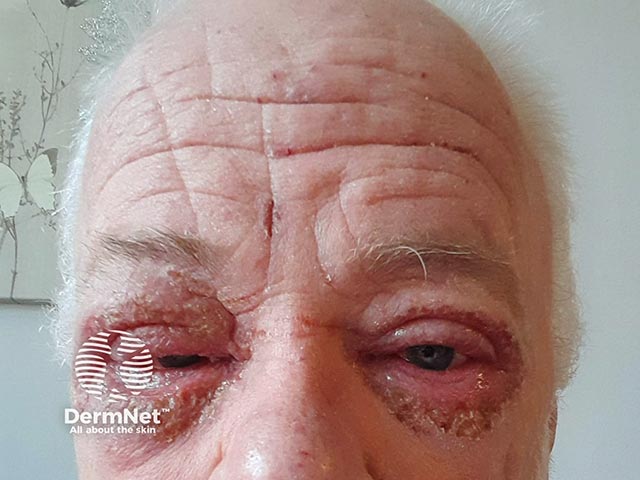Main menu
Common skin conditions

NEWS
Join DermNet PRO
Read more
Quick links
Last Reviewed: August, 2025
Author(s): Dr Keri McLean, Ophthalmology Specialty Trainee; Dr Anuj Vakharia, Ophthalmology Specialty Trainee; Dr Nima Ghadiri, Consultant Medical Ophthalmologist, St Paul’s Eye Unit, Liverpool University Hospitals Foundation Trust, United Kingdom (2025)
Peer reviewed by: Dr Kate Kylie Velasco, Te Whatu Ora, New Zealand (2025)
Reviewing dermatologist: Dr Ian Coulson
Edited by the DermNet content department.
Introduction
Demographics
Causes
Clinical features
Complications
Diagnosis
Differential diagnoses
Treatment
Prevention
Outcome
Dupilumab-associated ocular surface disease (DAOSD) is a spectrum of eye-related adverse effects that typically present within four months of commencing dupilumab therapy.
DAOSD symptoms are generally mild to moderate in severity and can range from nonspecific symptoms to discrete conditions such as conjunctivitis and keratitis.
Approved indications for dupilumab include atopic dermatitis (AD), chronic spontaneous urticaria, bullous pemphigoid, prurigo nodularis, asthma, and chronic rhinosinusitis with nasal polyps.

Dupilumab-induced ocular disease 8 weeks after treatment initiation (OADR-patient1)
Risk factors for dupilumab-associated ocular surface disease include:
The pathophysiology of dupilumab-associated ocular surface disease is not fully understood. Proposed hypotheses include:
Patients typically present with mild-to-moderate, nonspecific ocular symptoms. This can include:
Conjunctivitis and dry eye are the most commonly reported ocular side effects, followed by blepharitis, with cases of keratitis reported infrequently.
Although not specific to DAOSD, complications of ocular surface disease can include:
Dupilumab-associated ocular surface disease is a clinical diagnosis based on the history, ophthalmic examination, and temporal association with dupilumab treatment.
Slit-lamp examination of the ocular surface may demonstrate conjunctival hyperaemia (redness), papillary conjunctivitis, and superficial punctate keratopathy (damage to the cornea’s outer layer) in the early stages of DAOSD.
Dupilumab-associated ocular surface disease responds well to medical treatment, and discontinuation of dupilumab is not usually required.
There is no consensus on the specific management of DAOSD, but treatment strategies generally aim to halt the inflammatory process:
Patient or caregiver education is crucial. They should be counselled on:
There is limited evidence for lubricating eye drops as prophylaxis, particularly for patients with atopic dermatitis.
Nearly all cases of DAOSD resolve with the initiation of medical treatment. Cases also resolve with discontinuation of dupilumab, though this is not usually required.